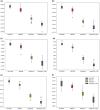MLACNN: an attention mechanism-based CNN architecture for predicting genome-wide DNA methylation
- PMID: 37648910
- PMCID: PMC10564812
- DOI: 10.1007/s12064-023-00402-3
MLACNN: an attention mechanism-based CNN architecture for predicting genome-wide DNA methylation
Abstract
Methylation is an important epigenetic regulation of methylation genes that plays a crucial role in regulating biological processes. While traditional methods for detecting methylation in biological experiments are constantly improving, the development of artificial intelligence has led to the emergence of deep learning and machine learning methods as a new trend. However, traditional machine learning-based methods rely heavily on manual feature extraction, and most deep learning methods for studying methylation extract fewer features due to their simple network structures. To address this, we propose a bottomneck network based on an attention mechanism and use new methods to ensure that the deep network can learn more effective features while minimizing overfitting. This approach enables the model to learn more features from nucleotide sequences and make better predictions of methylation. The model uses three coding methods to encode the original DNA sequence and then applies feature fusion based on attention mechanisms to obtain the best fusion method. Our results demonstrate that MLACNN outperforms previous methods and achieves more satisfactory performance.
Keywords: Attention CNN; Genome wide methylation detection; Hybrid neural network.
© 2023. The Author(s).
Conflict of interest statement
The authors declare that they have no competing interests.
Figures






Similar articles
-
Predicting environmentally responsive transgenerational differential DNA methylated regions (epimutations) in the genome using a hybrid deep-machine learning approach.BMC Bioinformatics. 2021 Nov 30;22(1):575. doi: 10.1186/s12859-021-04491-z. BMC Bioinformatics. 2021. PMID: 34847877 Free PMC article.
-
CNN-Siam: multimodal siamese CNN-based deep learning approach for drug‒drug interaction prediction.BMC Bioinformatics. 2023 Mar 23;24(1):110. doi: 10.1186/s12859-023-05242-y. BMC Bioinformatics. 2023. PMID: 36959539 Free PMC article.
-
EMDLP: Ensemble multiscale deep learning model for RNA methylation site prediction.BMC Bioinformatics. 2022 Jun 8;23(1):221. doi: 10.1186/s12859-022-04756-1. BMC Bioinformatics. 2022. PMID: 35676633 Free PMC article.
-
iDNA-ABT: advanced deep learning model for detecting DNA methylation with adaptive features and transductive information maximization.Bioinformatics. 2021 Dec 11;37(24):4603-4610. doi: 10.1093/bioinformatics/btab677. Bioinformatics. 2021. PMID: 34601568
-
Toolkits and Libraries for Deep Learning.J Digit Imaging. 2017 Aug;30(4):400-405. doi: 10.1007/s10278-017-9965-6. J Digit Imaging. 2017. PMID: 28315069 Free PMC article. Review.
References
-
- Abbas Z, Tayara H, Chong K. Spinenet-6ma: a novel deep learning tool for predicting DNA n6-methyladenine sites in genomes. IEEE Access. 2020;8:201450–201457. doi: 10.1109/ACCESS.2020.3036090. - DOI
-
- Alam W, Ali SD, Tayara H, et al. A CNN-based RNA N6-methyladenosine site predictor for multiple species using heterogeneous features representation. IEEE Access. 2020;8:138203–138209. doi: 10.1109/ACCESS.2020.3002995. - DOI
-
- Bahdanau D, Cho K, Bengio Y (2014) Neural machine translation by jointly learning to align and translate. arXiv preprint arXiv:1409.0473
LinkOut - more resources
Full Text Sources

